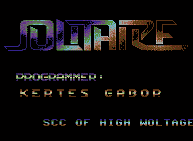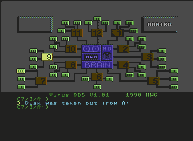|
In 1990 we were coding intros, demos and cracks for almost
two years. The local duel with BCB and HSA was over, demo writing
seemed a bit pointless. So, many of the things we learned was put
into two games. "Solitaire" is one of the earliest
computer implementation of solitaire games, and that makes me feel
good.
My first encounter with solitaires took place in the
mid-eighties. Around 1989 I saw a PC implementation of Klondike
(named Las Vegas). It was a pretty simple, character-based program.
With our knowledge of demo making it was obvious to start coding a
nice solitaire game.
Solitaire is completely my design. Writing a game wasn't my only
goal, writing an amazing one, that was what I wanted to do. I
participated in a program contest with Solitaire, unfortunately
I screwed up the presentation of the game to the Jury and took
only the third place.
As I mentioned before I tried to sell this game to a software house
in Holland. I found the name and address of the person to contact in
a Hungarian Commodore magazine. The man wasn't working for the
company anymore when I sent him the demo version, that's my luck.
The game has an auto-start routine, and the directory is modified to
trick the curious user. Try to load any files from the disk
(the ordinary way)... A turbo loader was introduced as well.

Solitaire Intro
|
|
Intro. The intro was completely coded by me. The logo and
the character sets are mine as well. The ten colors that are used
here have an influence over all the other parts of the game, the user always
knows that it's the same product. Teonaki composed the music for the
intro. Technically, the bottom (and bottom-sider)
border take off was then only a routine for us. The left and right
ends of the main logo are also in the borders. That code is a bit
filthy, but it's not easy to realize its error.
Menu. The menu of Solitaire presents the same ten colors
used in the intro. No technical brilliance here, just some nice
graphics.
Rules. Again, the ten colors are used in the small logo
and the raster bars. The rules are displayed in the bottom part of
the screen while in the upper part the name and difficulty of the
chosen solitaire are presented. The suits are in the four corners of
the screen, why not, "under" the border.
Game Play. Of course the three games have different game
plays. The common features are the pointer arrow and the time
counter (both in the borders). The game is played by joystick,
the "N" key for next and the "F" key
for foundation are also used. The sound effects are
Teonaki's.
Hall of Fame. Again the same colors in the design. And
that convex lens. It's just a nice little routine done by me
earlier for the last part of the Big Logo Disk. The 2x2 char-set is
made by Crazy Speed, music by Teonaki.
Get a life is a game of Teonaki. In this game you're a
virus and you have to kill a mainframe using some sort of
VOS ("Virus Operating System") from command line.
Unfortunately there's no running game in my possession, only some
graphics.

Game Board
|
|
The idea of this game was born in Teonaki's head, he wanted to
create a game in which the player would play the role of a deadly
computer virus. In those days encounters with viruses were pretty
common things. The game took third prize as well in the contest
mentioned above.
I don't remember exactly the game play. The main part of the screen
was the schematic map of a computer network with some terminals, and
a main frame. The goal was to kill the main frame, through infecting
machines. There was a central virus killer that removed infection
from machines. It was a real nice real-time game.
The bottom part was occupied by some sort of a console. The player
could execute commands there to control the virus, to infect another
parts of the network. The commands were interpreted and executed or
denied by the Virus Operating System.
The commands I was able to decipher:
- cls: Clears screen
- quit: Give up
- ver: Displays version info
- dir: Displays disk information of drive
- a: / c: (only on consoles): changes drive
- c1 - c12: changes console
- 1 / 2 / 3: changes local board
- cxx/y: changes console and board at the same time
- Some other command fragments I was able to discover, but was unable to
use properly: brain, tape, hico ?, hide ?, track.
I have absolutely no idea how you infect disks, machines, etc.
Synthesizer is a sophisticated synthesizer program. I had no
real programming in this product, only the splash screen and the
intro is my work.
This product was also presented in the program contest and took
first prize in its category.
|


